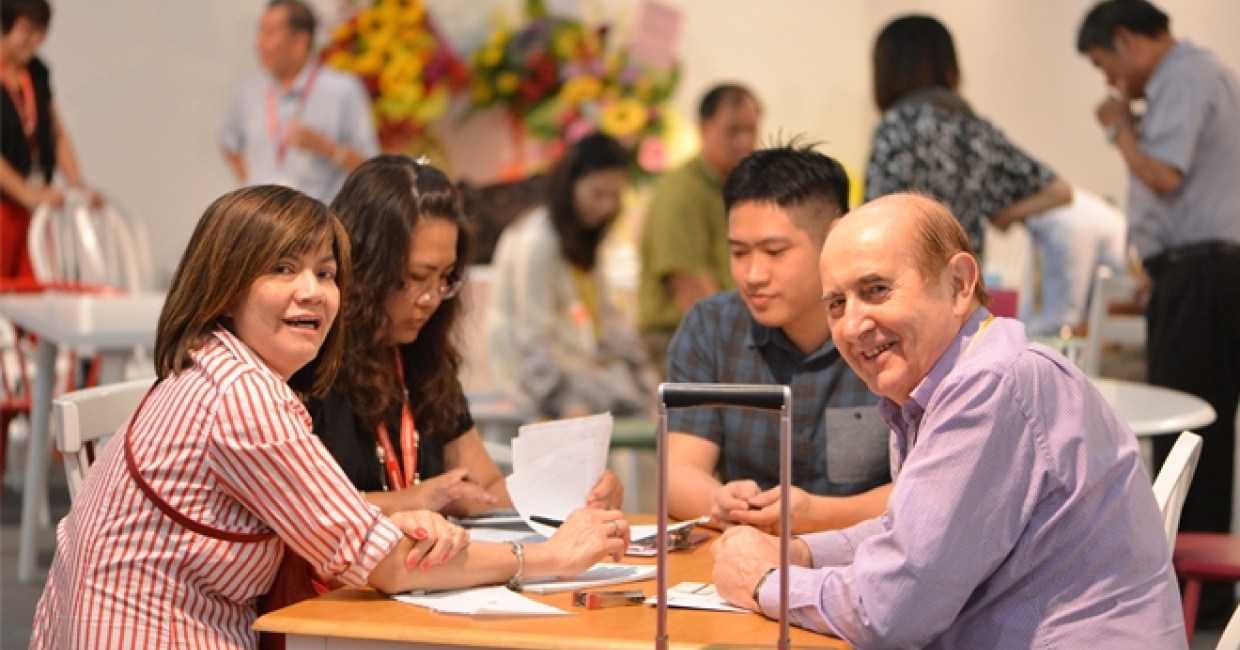This year, New Designers celebrated its 30th anniversary. Once again, the two-part exhibition brought together 3000 of the UK’s best new designers at the Business Design Centre in Islington, London. Furniture News’ Robyn Sirs-Davies was among the visitors impressed by the talented graduates, noting a few particular highlights …
New Designers 2015 reported great industry interest from a range of major companies, designers and talent-spotters. As with previous editions, the show was spilt into two sections – textiles and jewellery, and furniture and product design. The second part of the show ran from 1st-4th July, exhibiting an array of innovative furniture and surfacing designs.
This year, a significant rise in the number of products catering for health and environmental issues could be seen across the exhibited products. However, there were also many highly original pieces of furniture, as has become expected of the New Designers exhibitors.
One of the stand-out pieces of the show was the diamond lighting collection by Anna Reeve. The striking light shades are based on Anna’s perception of mathematic and geometric beauty, using parabolic curves to add fluidity to the otherwise sharp and sleek objects.
Crafted to the shape of a diamond, the metal lamps can be used in a pendant arrangement or as desk lamps – providing an unusual and impressive feature in either form. The lamp is available in warm, contemporary copper, steel or black powder coated steel. The collection also tapped into a popular woven loom trend that ran throughout various pieces at New Designers. The intricate web pattern at the apex of the lamp comes in a range of colours, which are dependent on the metal used – copper with black thread, steel with turquoise thread, and black steel with rust-coloured thread.
Byron Colman’s Ryse coffee table – created using 3D printing – was similarly innovative and mathematical. For his final year printing project, the designer was inspired by geometric shapes such as fractals – patterns that look the same at all distances – but wanted to add a natural twist to his product.
The coffee table itself is minimalist, featuring a white mirrored-gloss redwood surface. However, the white vine-like structures fixed to the top of each table leg add a striking twist to the design piece. The table is part of a range of items designed by University of Lincoln student Byron, who also launched his independent design label, Laird, at the show.
Juwon Seo’s Work Nest won the New Designers John Lewis Award for Design & Innovation. The simple work desk was designed to accommodate the increasing number of people who are working from home. The design of the desk encourages the psychological and physical separation of work life and home life, though they may exist in the same space. The soft furnishings and house shaped wooden frame evoke domestic comfort suitable for the home environment, whilst the fabric blinds allow for focus.
Another statement furniture piece that impressed me at the show was the Esker bench by Ben Ashby. Looking at human interaction in public places, Ben realised that public seating areas had a variety of purposes for the different people using them – some use communal areas for short or extensive breaks and some see them as either spaces for interaction or for tranquillity and respite.
“The event provided a significant platform for the young designers, and introduced new talent into the commercial world”
The Esker bench was designed to cater for comfort whilst remaining formal enough to be used in professional settings. Ben worked closely with experienced upholsterers to create a unique design that facilitated interaction in communal areas, without forcing people into close proximity. Ben says: “My inspiration was colour and texture, and how I can use them to address the blur between domestic and contract furniture. Esker provides seating for waiting areas and foyers. The stitched detail is used to separate the spaces on the bench, giving people a clear indication of how many people can fit on them.” The frame for the bench is crafted from solid ash, while the seat cushion is upholstered in Blazer fabric by Camira and available in a range of colours.
As well as the collection of universities that exhibit at the event, New Designers also selects past exhibitors to display their work in the One Year On hall. In this section of the show, visitors can see the progress that past exhibitors have made since their first appearance.
Robyn Hinchcliffe’s textile designs were amongst the most striking in this section of the show. Robyn produces innovative textiles for the home using a combination of machine-knitting and hand-weaving techniques. The Chelsea College of Art graduate began developing her own product range after completing her degree. The knitted rugs, wall hangings, cushions and other multi-functional interior fabrics are made from yarns sourced in the British Isles. Robyn also aims to use mill-end yarns wherever possible to minimise waste and support independent British suppliers.
Though the show was a new experience for me, it was clear that the event provided a significant platform for the young designers, and, most importantly, introduced myriad new talent into the commercial world.
New Designers will return in 2016 with Part 1 running from 29th June to the 2nd July and Part 2 between 6-9th July.






